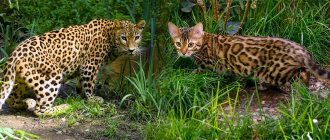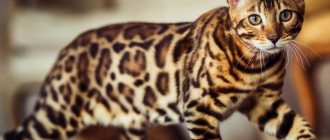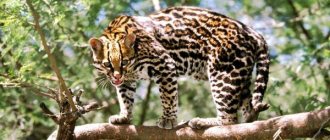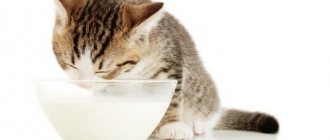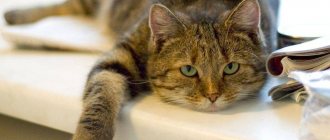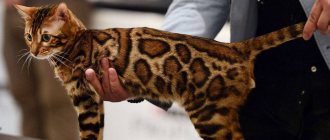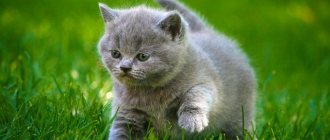Since the moment of official recognition of the Bengal cat breed, these rather exotic pets have attracted well-deserved attention. After all, Bengals are characterized not only by bright external characteristics, but also by the fun and playfulness characteristic of most cats, an open and friendly character and a well-developed intellect. Both adults and children can find a common language with a Bengal cat. Especially if the members of the family in which the Bengal appeared are accustomed to leading a healthy lifestyle and actively spending leisure time and, what is important, are sincerely ready to take care of the new pet and take responsibility for its comfortable stay with the person.
Who is best suited for a Bengal cat and how to make friends with it? What does she look like and how long does she live? What are her dispositions, habits and favorite treats? FAN presents a brief “encyclopedia” of the life of representatives of the Bengal breed.
pixabay.com/
The most popular hybrid spotted cat breeds
Most of these are animals obtained by crossing with wild cats.
Bengal
A hybrid of the Asian Leopard Cat or Lesser Leopard (ALC) and a domestic cat, bred by American breeder Jean Mill. Selection work began in 1961. Today the breed is recognized by all felinological systems of the world. The animal has been a pet since the fourth generation.
The first individuals were exclusively “golden” in color - there were black spots on a red background. With the development of the breed, pets of different colors were obtained:
- silver - the main background is silver;
- snow - in three modifications - linx, mink and sepia;
- marble - the spots merge into a large “cloak” or “sparble” pattern;
- charcoal - on a black background there are marks of the same color, while this is an experimental color.
snow bengal
charcoal bengal
Today, especially popular are individuals whose spots on the skin are located in the form of “rosettes”, reminiscent of the pattern of a jaguar’s fur. The most valuable pattern consists of three colors.
Even Bengals of the Siamese-Himalayan type have been bred. But no matter the color, the coat is the main distinguishing feature of this breed. It must have a “wild” pattern and is of the highest quality - short, without undercoat, tightly adjacent to the muscular body, glittery.
A kitten experiences phasing at two to five months, a process characteristic of wild cats. The bright pattern is hidden under the long secondary hair. The baby “blooms” to the age when his physical development allows him to protect himself from enemies and obtain food, in full accordance with natural canons. Excessive hair loss occurs only during this period of time; in adult life, the Bengal cat does not shed. This charming animal is rightfully called the “domestic leopard” due to its exceptional exotic coat pattern and energetic temperament.
Toyger
This is a “defective” Bengal, in which the standard prohibits the merging of spots into stripes.
The genetic fixation of this deficiency helped the emergence of a new breed. It was created by Judy Sugden, daughter of Jean Mill. Not all felinological systems have yet received recognition.
Toyger
The colors of the Toyger are the same as those of the Bengal cat.
Savannah
The largest modern cat breed. It is a hybrid of Serval and Abyssinian. Registered by breeder Patrick Kelly in 2001 in the American felinological system TICA.
Savannah got the leopard coloring from a wild ancestor. Its color varieties are gold, silver, brown (ed), chocolate, cinnamon.
Savannah
By nature, these cats are very curious and intelligent, easy to train. They do not tolerate loneliness well. Active, jumping and busy pets need a lot of space to play and love water very much.
Serengeti
A hybrid of Bengal and Oriental was created in California in 1994 by breeder Karen Sauzman. Due to its close resemblance to the Bengal cat, the breed is not widespread. Registered only in the American TICA system.
Basic moments
- Bengal cats are representatives of an elite breed.
- They are distinguished by their visual appeal, gracefulness and recognizable color.
- These are loyal and responsive pets that easily adapt to the rules of life in a permanent family and do not show unmotivated aggression.
- Ideal for experienced owners who are ready to give their cat a lot of attention and be a companion in active games and walks.
- They stand out among others with their sharp mind, training potential and developed communication skills.
- They are clean, value comfort and a friendly atmosphere.
- Animals of this breed are highly valued by experts at international exhibitions. Thus, in the top 25 of the overall rating of “best cats” according to The International Cat's Association in 2016 there are two Bengals, and a year earlier there were four.
The Bengal cat is a rather rare and therefore especially valuable specimen. The beauty, strength and grace of large predators are truly mesmerizing, but, of course, few people would think of keeping a tiger or panther in their apartment for reasons of humanity and basic safety. But a small domestic “leopard” is a very real alternative. The Bengal breed combines the best features of its ancestors: not only an attractive appearance, but also intelligence, curiosity, activity, and friendliness.
The most popular spotted breeds of domestic cats
The tabby color is also found in breeds bred without crossing with wild cats.
Ocicat
In appearance it resembles the brightest cat in the world, Ocelot, and got its name in honor of him. Although it has no relationship with a wild cat, but was obtained by crossing a Siamese and Siamese-Abyssinian mestizos.
By its temperament, the Ocicat is a cheerful and playful pet, loyal and affectionate, sociable and loving.
The colors vary in color, but always with spots.
Egyptian Mau
Descended from common street cats of Cairo. Exported to America in the fifties of the last century. One of the oldest natural breeds in the world.
The color of the short, dense coat can be different - silver, bronze, smoky, pewter. But always a tabby - and only a dark spot. A distinctive feature of his appearance is the “scarab” mark on his forehead and the black “eyeliner” of his expressive green eyes.
This small, muscular and very active cat has a balanced and independent character. She is attached to people, does not like loneliness, and is friends with all pets. Loves to talk with family members. The sounds that the Mau makes are not always like meowing, but resemble the “mumbling” of a person.
And you can learn more about this cat by reading the article about the Egyptian Mau on our portal.
Pixiebob
The Elf with the Short Tail was developed in the United States in 1985. The exact origin of the breed has not been determined; there is a version that wild cats participated in the selection, but this has not been confirmed by anything.
The pixie bob is characterized by the appearance of a lynx with tufted ears and a short tail. Polydactylism is common. The short or semi-long coat is always tabby in color - with spots or “rosettes”.
In their devotion to humans, these cats resemble dogs. Very calm, attentive and observant pets are friendly and love to play with children. They swim excellently, climb trees, hunt, “talk”, making beautiful curling and chirping sounds. They get along well with other pets, but are always leaders.
British Shorthair and Scottish Fold cats
The British and Scottish Fold are essentially different types of the same breed, although they are registered separately in feline systems. These are some of the most popular and oldest domestic breeds in the world.
By nature, these pets are self-sufficient, almost always phlegmatic. They like to sleep, but are not fans of active pastime. They are attached to people, love and do not offend children. Unpretentious and calm.
The colors of these cats are varied, spotted colors are very common.
American Shorthair (Kurzhaar)
This breed developed from its European relatives, who migrated with humans to America. A group of breeders began working on the approval of the variety at the beginning of the twentieth century.
The most famous color is the silver tabby - bright black, rather large spots on a light gray background.
The character of the American is called the “golden mean”, the cat is calm, does not require constant human attention, is moderately active and very devoted to the owner and all household members.
European Shorthair
The spotted color of this oldest breed is widely popular. The oldest European native variety was registered and presented to the public only in 1982.
A kind, energetic animal is deeply devoted to humans, willingly plays with children and at the same time never loses its hunting instincts.
Siberian
This natural oldest Russian breed most likely descended from Oriental cats brought to Siberia by merchants.
Animals with long hair and a thick undercoat are excellent hunters and have an independent and calm character. They are sincerely devoted to the owner and all household members, but do not like attention and affection imposed on them.
Among the many colors of Siberians, tabby is common.
Maine Coon
The raccoon cat is the pride of Americans. This natural breed has long been in the lead as the largest. The size of an adult cat (length with tail) reaches one and a half meters and weighs sixteen kilograms.
This pet is calm and undemanding, friendly and devoted to humans. But at the same time, like its ancient wild ancestor, it is an excellent hunter.
The colors of the coon are varied, spotted is quite popular.
The rarest spotted cats
Leopard-colored cats are also among the new experimental breeds that have not yet found recognition.
Australian Smoke (Mist)
Breeder Labor Street from Sydney carried out enormous selection work, which involved simple and purebred cats - Abyssinian, Siamese, Burmese. Among the many colors, tabby is one of the most common.
Mist inherited excellent health from the barn cats, and extraordinary grace and dignity from the elite. Gets along well with any pet, is devoted to people, loves children, is active and energetic. Approved by a limited number of felinological organizations, it is not widely distributed.
California radiant
Despite its wild appearance, this is not a hybrid breed, but a mixture of many varieties of cats - British Shorthair, Manx, Siamese, Angora, Abyssinian.
Created by American screenwriter Paul Casey as a symbol of wild African cats, mercilessly destroyed by humans. Very smart, friendly, silent and undemanding pets are still very rare and are registered only in the TICA felinological system (USA).
There are eight colors - black, brown, blue, bronze, charkoal (smoky anthracite), red, gold and silver. Always tabby.
Ussuri cat
This natural breed was noticed relatively recently. Most likely, it came from crossing Amur and Siberian cats.
It has been registered as experimental since 1994, but so far its representatives are very rare in the world.
The main color is from golden to fawn, always tabby. A very independent, self-sufficient and proud pet has all the habits of a predator. Temperamentally, he is more like the latter. Doesn't get along well with other animals, is a loner by nature and an excellent hunter.
Soukok or Sokoke (Kenyan Forest Cat)
It is believed that the ancestors of this very rare breed are wild kazonzo and secondarily feral domestic cats.
Through the efforts of the English breeder Jenny Slator, the breed was approved in 1992 in Denmark.
These slender and lithe cats are small in size, but strong and muscular. The dense and short coat can be of different colors, but always tabby, usually merle.
Playful and very intelligent animals are quite willful and independent. At the same time, they get along well with both humans and other pets. Wonderful hunters.
Wild spotted cats - pets
Wild leopard cats are very beautiful. The fashion for keeping them at home has arisen more than once in the human community. But not all representatives of the cat world can be safely placed in a house.
Today, only three spotted species are most widespread as pets.
Serval
The African bush cat is a medium cat. Body length with a short tail is up to one and a half meters, weight - up to twenty kilograms. A small head, long legs and high-standing large ears make this animal look like a cheetah.
In order for a Serval to grow up tame, it must be taken away from its mother in the first days of life and fed by hand. Therefore, you should only purchase such a pet from experienced breeders.
A properly raised kitten will grow into a friendly cat, but its wild roots must not be forgotten. An adult must have a separate enclosure.
Food: raw meat only. During growing up, great attention should be paid to ensuring that there is enough calcium in the diet. Children have fragile limbs and fractures often occur.
The Serval's coloring is magnificent - dark spots on a reddish background.
Read more photos and interesting information about the serval in a separate article on Mister Cat.
Ocelot
A very bright animal, resembling a leopard in appearance, although smaller in size.
Less accommodating and less trainable than the Serval. An adult should only be kept in an enclosure. Nevertheless, it is often found today in home keeping because of the extraordinary beauty of its amazing colors. Such a pet named Babao lived with the famous artist Salvador Dali.
Geoffroy's cat
This small wild animal is similar in size to its domestic counterpart.
The brightly spotted skin was highly valued in the fur industry. Today this species is on the verge of extinction and is protected by the CITES Convention.
Therefore, it is now rarely found in home keeping, although it is popular. It is well tamed if at an early age the pet was taken from its mother and raised in the hands of a person. There are only a few breeders of this species, and it is difficult to acquire such a cat.
Expert advice
Experts and experienced Bengal breeders advise buying a kitten only from a trusted nursery.
It is important to check the pedigree documents of the future pet. A Bengal with sore eyes, who is aggressive, scratches and often sneezes should not be adopted
The color of babies may not match that of an adult. A few months later he gains his contract and bright tone.
Elderly and calm people, as well as families with an infant, are better off not buying such an active breed. The sexual activity of male cats is addressed by spaying and neutering to prevent them from marking territory and singing their songs at night.
Some representatives of the breed can be overly jealous and selfish in nature. They do not tolerate dogs or other cats in the house, although as a leader they can get along with other furry household members from an early age.
Cats of this breed protect their territory and distinguish strangers from household members. They are not given to uninvited guests.
Peculiarities of behavior of spotted cats
Spotted coat coloring is the best camouflage for a predator. Pets with leopard coloring carry the gene of wild ancestors in their blood or are as close to them as possible. This explains their energetic and active character. Such animals need a large space for play, often love water and swim well, and are excellent hunters and fishermen. Like any wild cat, they are independent and self-sufficient. You should not try to forcefully pick them up, sit them on your lap, or play with them. Little “leopards” will come to a person on their own when they see fit.
Spotted cats are very smart, real intellectuals. They easily learn the simplest commands, remember a fairly large set of words perfectly, and quickly get used to wearing a harness.
With proper early education, they socialize well and never show aggression.
They are very attached to their owner and yearn for loneliness. It is better to keep such animals in the house in pairs. Then, in the absence of household members, they will perfectly occupy themselves, quickly make friends with any other pets, but will always remain leaders. Just don’t introduce them to parrots or rodents - most likely, the hunting instinct will be stronger than their liking. For pet “leopards” it is necessary to purchase a large play complex, exercise equipment and interactive toys. Their energy always requires an outlet.
Spots and stripes on a cat's fur are an amazingly beautiful pattern created by nature. Spotted domestic cats of different breeds are distinguished by their grace and love of life.
Potential Health Problems
Most Bengals are distinguished by good health, obtained thanks to the genetic data of their wild ancestors. But there are a number of diseases that you may encounter:
- Digestive disorders and food poisoning.
- Diseases of the gastrointestinal tract that are inflammatory in nature.
- Cardiomyopathies.
- Polycystic kidney disease.
- Flat sternum syndrome (genetic defect).
- Leukemia.
- Pathologies of the endocrine system (hormonal disorders, often found in unsterilized pets).
- Dry nose syndrome.
- Urolithiasis disease.
Photo: @bengal_lys/Instagram
Spotted cat breeds
Spots on the fur are characteristic of all wild representatives of the cat family. Large animals such as the leopard, ocelot, serval, speckled cat (fishing cat), Geoffroy's cat, European forest cat and many other species can wear a skin with various inclusions.
Bengal Cat running and jumping in Snow
Spotted kittens are very beautiful and playful
Spotted domestic cats inherited the coloring from their wild relatives. A cat with spots can be found in almost every breed. At the same time, you should know that all felines have a pattern on their fur (stripes or spots), but not all of them have it visible.
Interesting fact! Spotted cats, which are also called “sprat” cats, seem to some people to be unattractive and ugly. Absurd delusion! Variegated colors adorn the pet.
Pixie bob
The pixie bob or short-tailed elf is similar in appearance to a lynx. Breeders achieved this unusual look after long experiments in crossing domestic cats with wild short-tailed cats, residents of American and Canadian forests.
The pixie-bob looks like a miniature lynx: the same tufts on the ears, the same eye shape. The thick silvery or brownish coat is covered with small dark spots.
Short-tailed elves are very affectionate and sociable, they love to play and even swim. A short tail and multiple toes are the distinctive features of pixie bobs.
This is interesting! All cats of this breed have additional toes, their maximum number can reach 28 - 7 on each paw.
Savannah
In the 1980s, breeders crossed the domestic cat with the African Serval, resulting in the Savannah breed.
A large, long-legged cat with spots weighs up to 15 kg and grows up to 60 cm at the withers. Outwardly, it looks like a leopard. Savannah's ear can rotate 180°, which allows its wild relatives to perfectly navigate in open space.
Savannahs are distinguished by rounded ears and thick, spotted fur that is chocolate, golden or silver in color with black spots. These animals have a calm, balanced character and developed intelligence.
They are very active, love walks and swimming, and need to exercise a lot. A spotted Savannah cat can make sounds that are unusual for domesticated pets, for example, hiss like a snake. With this hissing, Savannahs not only express their displeasure, but can also warn of danger.
Ocicat
The breed of domestic cats, resembling the color of their wild relative the ocelot, is called Ocicat.
Despite the external similarity and the name of the breed, the Ocicat is not a descendant of the ocelot. This domestic breed was developed in the second half of the twentieth century as a result of crossing Siamese, Abyssinian, American Shorthair and some other spotted cats.
After several experiments, graceful spotted kittens were born. The Ocicat has a long muscular body, graceful thin legs, and a head in the shape of an elongated triangle. The coat color can be blue (silver), ivory or cream.
There are small dark spots all over the body. There are horizontal stripes on the neck that resemble a collar. You can see “rings” on the paws.
This is interesting! The Ocicat is a very affectionate, playful cat. She easily learns new things: a smart cat will quickly learn to bring a fallen object to its owner.
The spotted favorite of the Ocicat breed does not tolerate loneliness well and needs communication with humans and other pets or relatives. This graceful animal loves to run and jump, so it needs toys and space to play. Ocicats are in good health, but may have problems with their teeth and gums, so they need to be cleaned periodically. But short hair is not difficult to care for.
Fold cat
Spotted tabby is one of the colors of the Scottish Fold cat. Dark spots are visible on the legs, body and tail. Black lines are visible around the eyes and nose.
The spotted cat has the floppy ears characteristic of the Scottish breed. Clearly defined small and large spots are located throughout the body. The coat can be silver, cream, or bluish. These are calm and affectionate pets who love to play and communicate with people.
Scottish Fold Spotted Tabby
Ussuri
The Ussuri cat appeared in the Far East as a result of natural crossing of the domestic Siberian cat with the Amur forest cat. In the wild, Siberian cats mate with Amur forest cats, resulting in large spotted kittens. The breed was not specially bred; moreover, the efforts of breeders did not improve it at all.
For reference! Ussuri (leopardette) is a small breed that has not received recognition outside of Russia.
The Ussuri breed has a powerful, muscular body, full cheeks and rounded ears with tufts. The thick, short, shiny coat is golden, fawn or brown, covered with black or bronze spots, stripes and rings. The dense and thick undercoat reliably protects this cat from the cold.
Ussuri are friendly, but they cannot be called affectionate. They have an independent and independent character. It is advisable to keep such pets in a country house so that the animal has its own territory. Ussuri love silence and solitude. They have highly developed hunting qualities. They have good health, so they require simple care: regular vaccinations, washing and combing their hair.
Important! Ussuri is a very rare and small breed.
And others
Representatives of a wide variety of breeds can be spotted. Among them are the most common:
- Asian tabby;
- American Shorthair;
- American Bobtail;
- American Curl;
- Arabian Mau;
- Bengali;
- Bristol;
- Egyptian Mau;
- European Shorthair;
- California radiant;
- Kanaani;
- Cymric;
- Kurilian Bobtail;
- Serengeti;
- chito.
The fur of cats of these breeds has clear, bright spots that form an interesting and beautiful pattern. In other breeds, spotting is also sometimes present, but not so pronounced.
Conditions of keeping: how to arrange a comfortable stay for a Bengal cat in the house
Household items that are truly vital for Bengal cats include:
- separate bowls for food and water;
- a lounger-bedding or a box - a house, you can use a spacious basket;
- a toilet in the form of an open tray or a closed structure, with filler in it (it happens that a cat does not go to the tray, preferring the toilet);
- toys in a wide range of sets - sticks, balls, artificial rodents, a running wheel, ideally a play complex is desirable, various houses - Bengals have an increased need for active games;
- scratching posts preferably of two types - with hard and soft structures (wood, cork, rope, bark).
Also, from time to time a special carrying box or bag for transportation is required.
Special devices
Scratching posts help save the decor and interior of the house from the claws of domestic predators. Even if the pet is walking outside, in the apartment he will sharpen his claws several times a day
When choosing an accessory, pay attention to:
— stability, structural strength;
— quality of materials, functionality;
— a height sufficient for an adult animal: a Bengal cat actively stretches its body to grasp with its claws.
What types of harnesses and collars are there?
Collars are purchased for different purposes - therapeutic and prophylactic and for walking, decorative for aesthetic purposes, and informational - so that a lost animal finds its home again. Nowadays special harnesses are produced for walking.
Walking harnesses are leashes of a special design that are preferable to a collar due to their safety for the animal. The cat's neck will not slip out of such a leash, and the danger of getting caught on anything is eliminated. Various designs distribute the load and do not put pressure on the pet's throat. Walking harnesses are:
— V-shaped, when the connecting bar of the loops falls on the cat’s chest;
- H-shaped, in which the bar rests on the back;
- in the form of two loops connected by a figure eight;
- in the form of a vest - such designs also allow you to protect the cat’s fur coat from dust, precipitation and dirt in some places.
Owners can choose soft leather, light cotton, durable, practical nylon harnesses.
Choosing a collar
The range of cat collars is even more diverse. For safety, they can be equipped with either stretchable inserts made of elastic materials, or special fasteners that operate under increased load and prevent suffocation of an animal hanging on a fence or branch. According to their intended purpose, these cat accessories are produced:
- to prevent flea infestation and ticks on the skin - these are impregnated by manufacturers with chemical compounds and can either destroy insects or act on larval eggs, interrupting their life cycle;
— for the purpose of identifying a lost animal (addressed products with a medallion or information written on the strip itself);
- for returning home independently from a walk - a built-in magnet opens the door;
- to give the animal a glamorous or shocking look - such collars satisfy the ambitions of the owners, but the cat itself is not needed.
Chips are now widely used, usually implanted under the cat's skin or attached to the ear. Sound, reflective, animal calming and even GPS collars are available that will allow the owner to monitor the pet’s movements.
The breed of domestic and wild leopard cats combines predatory grace with an accommodating, albeit independent character. With proper care, decent maintenance, and attentive attention, a Bengal cat will delight its owners for a long time with its appearance, good disposition, and decent manners of a well-bred pet.
Origin of spotted color in cats
Many modern scientists are confident that the Libyan spotted cat became the ancestor of the domestic cat. From her, all modern representatives of domestic purrs have inherited the genes responsible for their spotted coloration.
For reference! All cats have a pattern on their fur, but it is not always noticeable. Even a completely black or white cat may have stripes and spots of the same color, but this pattern cannot be seen.
The presence of the dominant gene A (agouti factor) in the cat’s genome determines whether the pattern on its coat will be visible. Spotted cats inherit several genes responsible for their pattern and its location.
Domestic animals of spotted color first appeared in the 18th century in England. Spotted is a type of tabby color. This includes any colors with patterns.
There are 4 types of patterns: spotted, brindle, marbled and ticked. All tabby cats have noticeable M-shaped stripes on their foreheads.
A cat's eyes may be lined with black, brown, red, lavender, blue or pink, depending on the base color of the coat. In the wild, tabby coloring and spotting are needed for cats to camouflage against leaves and grass. The spotted color combines the characteristics of other tabby species. The spots resemble broken tiger stripes or the streaked patterns characteristic of marbled cats.
Signs of spotted color:
- the spots form a clear line along the length of the entire body from the withers to the tail;
- “buttons” are noticeable on the stomach;
- "necklace" on the neck.
Spotted color cannot be determined for sphinxes, as well as for other varieties (acromelanic, harlequin, van).
Spots with clear boundaries can have any shade: cream, red, blue, chocolate, black, lilac, fawn and cinnamon. The spots are evenly distributed throughout the animal's body. The background is much lighter than the spots.
Spotted cats have noticeable M-shaped stripes on their foreheads.
Buying kittens
Leopard cats are an extremely rare breed in Russia. Therefore, when buying such a pet at the market, in a pet store or through an advertisement, you can buy an ordinary yard cat that will only vaguely resemble a leopard.
Bengal kitten
If you have decided to buy just such a pet that meets all standards, then it is best to do this in a nursery or from a breeder registered in Russia.
What to look for when choosing a kitten
It is best to purchase a leopard-colored kitten when it is three months old. During this period, the child's pattern fades and changes to an adult one. The coloring is finally formed by the age of eight months. It is impossible to pick up a leopard breed baby before he reaches 2.5 months of age.
Note! When choosing a pet, you should carefully examine the baby and its coloring. It is better to give preference to the most curious and active kitten.
You should look at its spots and pattern. The kitten's mother should also be assessed. If this is not possible, then you can ask the seller for at least a photo. By the appearance of the mother, she will know what to expect from the baby in the future. The color of the mother's coat should be bright and the pattern clearly defined.
The best breeders and nurseries
Today in the Russian Federation there are about 150 organizations that are engaged in breeding leopard animals. The most common of them are the following nurseries:
- Wildbenjamin;
- Gelense Style;
- Bengalina Pride;
- Saeva Gratia;
- Shine Golden Irbis;
- Amaty Cay;
- New Generation;
- Volgabengal;
- Honey Sallada;
- Crimean Pride.
These are not all nurseries where you can buy leopard cats.
How much does a kitten cost approximately?
The cost of a kitten is determined by compliance with the standard and its pedigree. Depending on this, you can purchase kittens at a price of 7 to 15 thousand rubles. without pedigree. In nurseries, the cost varies from 15 to 30 thousand rubles. Adult individuals for breeding with excellent breeding qualities cost between 50 and 100 thousand rubles*
Picture 10. A purebred Bengal cat is quite expensive.
The leopard cat is an unusual and unique animal. The color of this pet resembles a leopard. Having adopted such a kitten into your family, you need to take care of providing it with proper upbringing and proper care. Only in this case can you raise a tame cat that will become a favorite and a full-fledged member of the family.
*Prices are as of September 2022.
Features of caring for domestic cats
A loving owner cares about the health of his pet. Spotted felines are active and curious, so they sometimes get injured. You need to carefully monitor their behavior and, if possible, prevent trouble.
All pets must be vaccinated against infections. This will protect your furry pets from many deadly diseases. In general, spotted cats do not require any specific care. They need to be cared for just like any other furry pet.
Grooming
Almost all spotted cats are short-haired, so brushing them once every 1-2 weeks is sufficient. Cats are very clean animals, so they only need to be washed if the pet gets dirty in something.
Cats keep their fur perfectly clean
Food for spotted cats
These animals are very active and spend a lot of energy, so they need a balanced, nutritious diet, like all other cats. It is advisable to feed them the best premium food that contains all the necessary nutrients.
Your cat's diet should be balanced
The spotted cat is a source of joy in the home. You can admire her endlessly. Motley beauties need care and love.
Cat breeds that look like tigers look very attractive and unusual. These days, such pets are no longer uncommon, but this was not always the case.
The American geneticist P. Casey was involved in crossing wild and domestic animals with a spotted coat. The result is that spotted cats have become suitable for living with humans.
Owner reviews
Bengal owners proudly note that their pets are loving and loyal. They are impressed by the responsiveness of furry companions and hypoallergenicity. Also, many note that Bengal cats are clean and show moderate character, which makes caring for them the most pleasant and calm process. Bengal owners advise choosing a Bengal kitten for those people who are ready for an active and loving animal.
Photo: @murphys_pawprints/Instagram
The most popular spotted cat breeds
If you want to have a spotted cat that looks like a leopard, future owners are advised to take a closer look at the following breeds:
Bengal
As a result of a genetic experiment, a breed of Bengal cats appeared. The scientist crossed leopards with ordinary outbred domestic cats.
Bengals are animals with a long, slender body and legs. The coat color varies from gray to brown. All individuals have oblong black spots on the body.
Bengals are a breed of spotted cats that are most similar to a leopard. In fact, the Bengal cat is a descendant of the leopard, although it has the character of a pet.
Features of Bengals:
- Sociable;
- Smart;
- Non-aggressive;
- Trainable;
- They love to swim.
The average price of a Bengal kitten is 10 thousand rubles, animals with a pedigree cost up to 50 thousand rubles.
Pixiebob
The breed was bred at the beginning of the 2000s. The selectors were faced with the task of creating spotted cats that looked like a lynx. Pixiebobs are a hybrid breed with a short tail (which is why the cat gets its name).
From the photo, pixiebobs are very similar to miniature lynxes, they:
- Get along well with other animals;
- Not aggressive towards people;
- They are affectionate and strongly attached to people.
Pixie beans were created artificially and relatively recently, so they have not become widespread.
Kittens are quite expensive, the cost of a pixie-bob starts from 40 thousand rubles.
Ocicat
That is the name of the cat breed obtained by crossing Siamese and Abyssinians. The name of the Ocicat breed is consonant with wild ocelots, because... cats look exactly like these animals. The breed was bred by the American V. Dale randomly.
Ocicats:
- Cannot have blue eyes;
- They do not have wild ancestors;
- The color can have many shades, up to smoky blue;
- Character – calm, friendly.
Ocicats are quite large, have high, oblong ears and almond-shaped eyes.
The price of an Ocicat kitten ranges from 35 to 160 thousand rubles.
Serengeti
A young breed, artificially bred in 2001. The ancestor of the Serengeti was Bengal cats, which is reflected in the color with clearly visible spots.
Serengeti cats:
- Curious, love to explore their surroundings;
- Aggressive towards some objects and animals, but not towards people;
- They do not get along well with dogs.
The price of a Serengeti kitten is 35 – 60 thousand rubles.
Australian smoke
The cat breed is like a leopard, but it occurred by crossing the Burmese and Abyssinian breeds. The Australian smoky cat has a bluish color; there are individuals with a marbled coat.
The breed has the following distinctive features:
- The body and head are medium in size;
- The ears are elongated, wide at the base;
- Almond-shaped large eyes;
- Friendly character;
- Not prone to aggression.
California radiant
Leopard cat, obtained in the USA after crossing three breeds. They have short fur of various colors with a brown tint.
Features of the Californian Radiant breed:
- A special gait, like that of wild cats;
- Very long, thin tail;
- The spots are round, square or triangular in shape.
The breed was bred in 1970 and has since been popular in the United States and around the world. California shining middle class kittens cost from 90 thousand rubles.
The offspring of premium individuals with a pedigree can cost up to 150 thousand rubles.
Range and habitats
Wild cats were popularized throughout central and western Europe. For some time they lived in southern countries - in Spain and Italy. Animals also lived in the territory of Asia Minor.
Today, forest cats can be found in the Caucasus and Ukraine. Also, animals invariably live in Europe. Forest cats surprisingly love to go to the mountains, to a height of 2-3 km above ground level. Central European cats have “settled” in the Caucasus since the times of the USSR.
Forest cats avoid almost all terrestrial predators, but wolves and foxes are the most dangerous for them. That's why cats prefer to go to the mountains or climb trees. They can stay in such a shelter for more than one month if they can get food for themselves.



